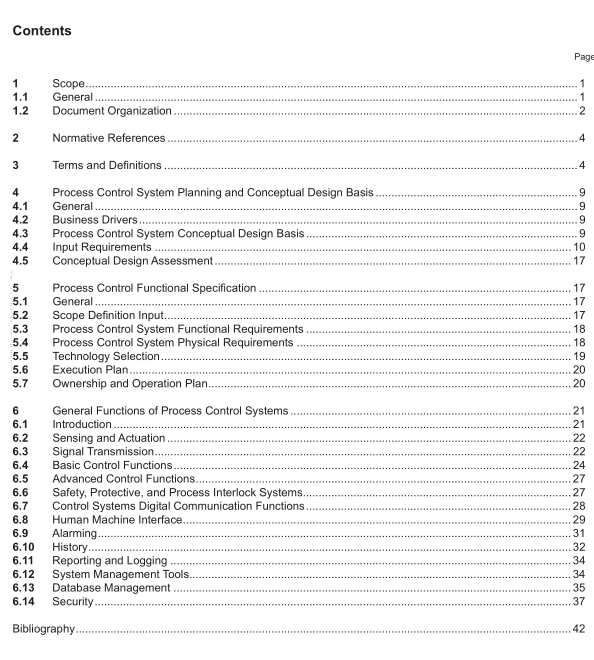API RP 554 pdf download

API RP 554 pdf download Process Control Systems— Functions and Functional Specifcation Development
3.8
discrete control
Control functions that involve on-off operations and interlocks. Discrete control variables are generally associatedwith thresholds above or below which a control action is taken. The control action is a discrete function such asopening or closing a valve, starting or stopping a motor, etc.
3.9
distributed control systemDcs
Ageneral term used for digital PCSs that use multiple processing modules to perform the functional tasks of thesystem. These modules may or may not be located in physical proximity to one another.
3.10
encryption
The coding and decoding of data transmissions using algorithms and encryption keys that are known only to thesending and receiving devices. A wide variety of encryption techniques and algorithms are available and havevarying levels of security associated with them.
3.11
enterprise resource planningERP
Systems that are used to identify and coordinate supplies of raw materials, intermediate materials, finishedproducts, consumables, and other material or resources required to operate a manufacturing business.
3.12
Ethernet
A networking standard that is either wireless or uses a single cable consisting of four pairs of wires to connectmultiple computing devices together in a manner that does not require that any of the devices be aware of the otherdevices. Ethernet is an asynchronous communications method that allows messages to collide and provides fora collision detection and a random pause and retry means of allowing multiple devices to communicate.Ethernetstandards are defined in the lEEE 1802.x series of standards.
3.13
fieldbus
Adigital communication network that connects the field sensors, transmitters, and control actuators together andto either a controller or control nework. A field bus network allows devices to send and receive messages overa shared path. Devices may send current measurements and/or diagnostic messages and receive commandsor configuration data.
3.14
field devices
Any sensors, measuring devices, control elements etc.that are used to senseor directly control process conditions.Current technologies allow increased “intelligence” to be added to the field devices, e.g. self-diagnostics, controlfunctions, and network interconnectivity.
3.15
firewall
A combination of hardware and software installed on computers and network connections to prevent undesiredmessages from a digital network from reaching or passing through the computers. A firewall may also hide thepresence of a computer from other computers on the network.See also 3.7, DMZ.
3.16
front-end engineering designFEED
Engineering activities performed during the identification of project scope and costs. These activities are generallythose necessary to develop designs to the point where scope and cost estimates can be supported. In a frontend engineering design environment, resources are placed early in the project to ensure proper collaborationbetween disciplines and to address potential issues in the design early enough to correct them.
3.17
gateway
Adistributed control system (DCS)or other PCS module that interfaces communications between foreign devicesor devices within the PCs that use differing communications technologies in a structured and secure manner.
3.18
hazard and operability analysisHAZOP
Ahazard analysis technique for process plant safety analysis in which potential hazards and existing or necessarysafeguards are identified, using a defined set of initiating words to examine conditions on particular nodes ofanalysis. Can also be known as a process hazard analysis (PHA).Specific procedures for carrying the safetyand reliability analysis of control and computer systems are termed as computer hazard and operation analysis(CHAZOP).
3.19
highway addressable remote transducerHART
A communications protocol which provides a means of device communications using a phase shift carrierimposed over a pair of wires. The wires may be dedicated to the communications path or may also carry standard4 mA to 20 mA analog signals. HART TM has evolved to a protocol that enables configuration and messaging ofthe field device in an effective way. See www.fieldcommgroup.org for more details.HART is an example only andits inclusion is not intended to endorse it specifically or limit users from considering other applications.
3.20
human machine interfaceHMI
A computing resource for a PCS that is used as an operator’s or engineer’s interface for displaying data orinputting information or operating commands.
3.21
local area networkLAN
A computer network connecting computers and other electronic equipment to create a communication system.These networks commonly use Ethernet or similar communications methods.
3.22
object linking and embeddingoLE
A Microsoft standard, object linking and embedding,which defines methods for applications to share commondata and applications.
3.23
open platform communicationsOPC
oPC standards provide a common practice for manufacturers of PCSs to make real time and historical dataavailable to other devices in a structured and deterministic way. OPC UA(Unified Architecture) is much morecomplex than previous OPC specifications and is designed to:









